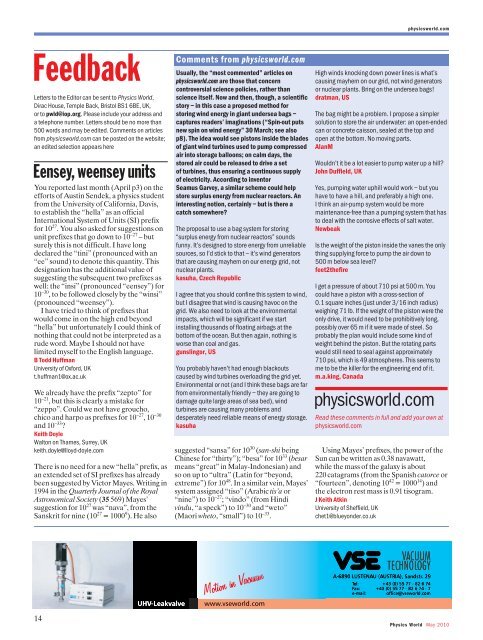special issue
special issue
special issue
You also want an ePaper? Increase the reach of your titles
YUMPU automatically turns print PDFs into web optimized ePapers that Google loves.
physicsworld.comFeedbackLetters to the Editor can be sent to Physics World,Dirac House, Temple Back, Bristol BS1 6BE, UK,or to pwld@iop.org. Please include your address anda telephone number. Letters should be no more than500 words and may be edited. Comments on articlesfrom physicsworld.com can be posted on the website;an edited selection appears hereEensey, weensey unitsYou reported last month (April p3) on theefforts of Austin Sendek, a physics studentfrom the University of California, Davis,to establish the “hella” as an officialInternational System of Units (SI) prefixfor 10 27 . You also asked for suggestions onunit prefixes that go down to 10 –27 – butsurely this is not difficult. I have longdeclared the “tini” (pronounced with an“ee” sound) to denote this quantity. Thisdesignation has the additional value ofsuggesting the subsequent two prefixes aswell: the “insi” (pronounced “eensey”) for10 –30 , to be followed closely by the “winsi”(pronounced “weensey”).I have tried to think of prefixes thatwould come in on the high end beyond“hella” but unfortunately I could think ofnothing that could not be interpreted as arude word. Maybe I should not havelimited myself to the English language.B Todd HuffmanUniversity of Oxford, UKt.huffman1@ox.ac.ukWe already have the prefix “zepto” for10 –21 , but this is clearly a mistake for“zeppo”. Could we not have groucho,chico and harpo as prefixes for 10 –27 , 10 –30and 10 –33 ?Keith DoyleWalton on Thames, Surrey, UKkeith.doyle@lloyd-doyle.comThere is no need for a new “hella” prefix, asan extended set of SI prefixes has alreadybeen suggested by Victor Mayes. Writing in1994 in the Quarterly Journal of the RoyalAstronomical Society (35 569) Mayes’suggestion for 10 27 was “nava”, from theSanskrit for nine (10 27 = 1000 9 ). He alsoComments from physicsworld.comUsually, the “most commented” articles onphysicsworld.com are those that concerncontroversial science policies, rather thanscience itself. Now and then, though, a scientificstory – in this case a proposed method forstoring wind energy in giant undersea bags –captures readers’ imaginations (“Spin-out putsnew spin on wind energy” 30 March; see alsop8). The idea would see pistons inside the bladesof giant wind turbines used to pump compressedair into storage balloons; on calm days, thestored air could be released to drive a setof turbines, thus ensuring a continuous supplyof electricity. According to inventorSeamus Garvey, a similar scheme could helpstore surplus energy from nuclear reactors. Aninteresting notion, certainly – but is there acatch somewhere?The proposal to use a bag system for storing“surplus energy from nuclear reactors” soundsfunny. It’s designed to store energy from unreliablesources, so I’d stick to that – it’s wind generatorsthat are causing mayhem on our energy grid, notnuclear plants.kasuha, Czech RepublicI agree that you should confine this system to wind,but I disagree that wind is causing havoc on thegrid. We also need to look at the environmentalimpacts, which will be significant if we startinstalling thousands of floating airbags at thebottom of the ocean. But then again, nothing isworse than coal and gas.gunslingor, USYou probably haven’t had enough blackoutscaused by wind turbines overloading the grid yet.Environmental or not (and I think these bags are farfrom environmentally friendly – they are going todamage quite large areas of sea bed), windturbines are causing many problems anddesperately need reliable means of energy storage.kasuhasuggested “sansa” for 10 30 (san-shi beingChinese for “thirty”); “besa” for 10 33 (besarmeans “great” in Malay-Indonesian) andso on up to “ultra” (Latin for “beyond,extreme”) for 10 48 . In a similar vein, Mayes’system assigned “tiso” (Arabic tis’a or“nine”) to 10 –27 ; “vindo” (from Hindivindu, “a speck”) to 10 –30 and “weto”(Maori wheto, “small”) to 10 –33 .High winds knocking down power lines is what’scausing mayhem on our grid, not wind generatorsor nuclear plants. Bring on the undersea bags!dratman, USThe bag might be a problem. I propose a simplersolution to store the air underwater: an open-endedcan or concrete caisson, sealed at the top andopen at the bottom. No moving parts.AlanMWouldn’t it be a lot easier to pump water up a hill?John Duffield, UKYes, pumping water uphill would work – but youhave to have a hill, and preferably a high one.I think an air-pump system would be moremaintenance-free than a pumping system that hasto deal with the corrosive effects of salt water.NewbeakIs the weight of the piston inside the vanes the onlything supplying force to pump the air down to500 m below sea level?feet2thefireI get a pressure of about 710 psi at 500 m. Youcould have a piston with a cross-section of0.1 square inches (just under 3/16 inch radius)weighing 71 lb. If the weight of the piston were theonly drive, it would need to be prohibitively long,possibly over 65 m if it were made of steel. Soprobably the plan would include some kind ofweight behind the piston. But the rotating partswould still need to seal against approximately710 psi, which is 49 atmospheres. This seems tome to be the killer for the engineering end of it.m.a.king, CanadaRead these comments in full and add your own atphysicsworld.comUsing Mayes’ prefixes, the power of theSun can be written as 0.38 navawatt,while the mass of the galaxy is about220 catagrams (from the Spanish catorce or“fourteen”, denoting 10 42 = 1000 14 ) andthe electron rest mass is 0.91 tisogram.J Keith AtkinUniversity of Sheffield, UKchet1@blueyonder.co.ukUHV-Leakvalvewww.vseworld.comVACUUMTECHNOLOGYGA-6890 LUSTENAU (AUSTRIA),Sandstr.29Tel:+43(0)55 77 -82 6 74Fax:+43 (0)55 77 -82 6 74-7e-mail: office@vseworld.comom14Physics World May 2010



